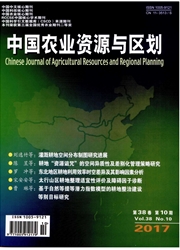

 中文摘要:
中文摘要:
中国的农业现代化必须建立在农业适度规模经营的基础上,农业生产走规模经营的路子也是现代化的需要。因此,农村土地承包经营权流转作为扩大农业经营规模、提高农业生产效益的手段不断被加以推广。新疆地区地域广阔,南北疆自然及社会经济条件差异大,因此不同区域农地流转条件和效果不同。本文在实地调研的基础上,将新疆的农地流转情况分为四大类型,统计分析农地规模,以探讨农地流转后是否能产生规模效益和农地流转的风险为主,运用DEA模型和案例比较的方法,对新疆地区农地流转的规模效益与风险进行分析。研究发现:以玛纳斯县为代表的北疆棉区棉农在农地转入后,农地总面积增加、户均每块地面积也增大,这表明农地流转使得植棉规模扩大并且产生规模效益,南疆则存在一定流转风险,主要分3类:生计风险、经营风险和交易风险。因此应分区分类指导流转。
 英文摘要:
英文摘要:
China's agricultural modernization must rely on appropriate scale operation of agriculture. Therefore, as the means of expansion of the scale of agricultural operation and improving the efficiency of agricultural production, the rural land contractual management right is being vigorously promoted. It is necessary for our government to en- sure the effective supply of agricultural products and promote the sustained and rapid income growth of farmers, and to enhance the comprehensive agricultural production capacity. Xinjiang located in the northwest of China with vast territory, and the natural and economical conditions vary greatly between south Xinjiang and north Xinjiang, so that the conditions and results of rural land transfer were different in different regions. Based on the data collected through investigations, this paper divided the conditions of agricultural land reforms in Xinjiang into 4 groups : Eco- nomic area in north slope of Tianshan Mountains, the agricultural and pastoral areas in north Xinjiang, the forestry and fruit areas in southern Xinjiang and the four poverty areas in southern Xinjiang. The DEA model and case com- parison method were used to analyze the agricultural land reform efficiency and the risk of agricultural land reform efficiency in Xinjiang. The results showed that: the agricultural land transfer in Northern Xinjiang cotton areas, such as Manasi County, increased the land total area and the average area of each household. It indicated that the scale of rural land circulation enlarged the cotton planting scale and improved efficiency in North Xinjiang. But there were some risks of agricultural land transfer in South Xinjiang including livelihood risk, agricultural produc- tion and operation risk land transfer based on , and land transaction risk. Therefore, it suggested that the government should support the the district planning and classification.
 同期刊论文项目
同期刊论文项目
 同项目期刊论文
同项目期刊论文
 期刊信息
期刊信息
